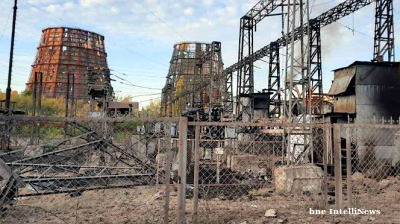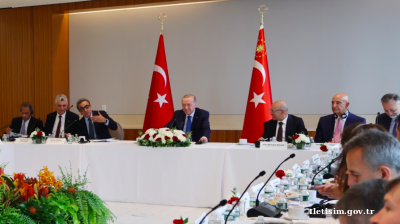POLITICS
There was of course no surprise in the outcome of Tajikistan’s October 2020 wholly undemocratic election as the country’s authoritarian President Emomali Rahmon officially won 90.92% of the vote, securing him a fifth consecutive presidential term.
The largely ceremonial day at the ballot box granted 68-year-old Rahmon, “Founder of Peace and National Unity, Leader of the Nation”, another seven years in all at the reins of the country, Central Asia’s poorest.

Rahmon at the Rogun dam construction site.
According to the 2017 Demographic and Health Survey conducted by the Tajik government together with international partners, 18% of the country’s children under five suffer from stunted growth because of malnutrition. Less than 10% of children between six and 23 months have minimum acceptable dietary standards, the same findings also showed.
Those with alternative ideas to Rahmon are, however, making few inroads. As 2020 neared its end, Tajik authorities said they had detained opposition leader Mahmurod Odinayev, deputy chairman of the Social Democratic Party, the only functioning opposition party in Tajikistan, which boycotted the presidential election, saying its result was a foregone and fixed conclusion. Odinayev apparently faces a charge of hooliganism.
In September, Tajikistan experienced a one-hour internet outage coinciding with an attempted address to the country by an exiled opposition leader, Muhiddin Kabiri, from the US. The address was streamed live online. The opposition Islamic Renaissance Party of Tajikistan (IRPT) led by Kabiri was banned in Tajikistan in 2015 and labelled a “terrorist organisation.”
Restive Pamirs
The Tajik powers that be will, in 2021, be looking out for any further trouble in the restive Pamirs region, otherwise known as the Gorno-Badakhshan Autonomous Region, or GBAO. Last spring, hundreds of residents in Rushan, a mountain town about 10 hours’ worth of arduous driving east of the capital, Dushanbe, emerged onto the streets and gathered before the local security service headquarters in an unusual show of defiance, said to have been in response to an arrest. Government forces reportedly fired shots in the air, but the crowd refused to be cowed.
In foreign policy, watch out for developments in 2021 in the troubled relationship between Tajikistan and fellow Persian-speaking country Iran. For the past few years, Dushanbe has kept picking fights with Tehran. In September, Tajik state television carried a sensationalist documentary that repeated accusations that Iran had funded militant activity in Tajikistan and, separately, the Supreme Court earlier sentenced dozens of graduates of Iranian universities to lengthy prison terms.
What is driving Tajikistan’s attacks on Iran is not clear. There is some speculation that Iran’s arch-rival, Saudi Arabia, has embarked on an aid-funded campaign to ally with Tajikistan to the detriment of the Islamic Republic. However, if Iran’s fortunes improve in line with the coming to power of Joe Biden in the US – there is substantial hope Biden will drop heavy sanctions that are crippling Iran’s economy – Tajikistan might see it as in its economic interests to strengthen relations with the Iranians.
In July, Iran exported its first tranche of goods to Central Asia via roads that form the new "Kyrgyzstan, Tajikistan, Afghanistan and Iran corridor (KTAI)".
Mounting defences against ecological threats is one area in which the Tajiks and Iranians may be wise to collaborate. In September, Iran, Tajikistan and Kyrgyzstan were among 19 countries listed by the inaugural edition of the Ecological Threat Register (ETR), released by the Institute for Economics & Peace (IEP), as the most fragile in terms of high exposure to ecological threats and the highest risk of future collapse in the decades ahead.
Particular “hotspot” countries including Iran and Tajikistan “combine high levels of ecological threats with low and stagnant socio-economic resilience”, the IEP said, noting that “the lack of coping capacity in these countries could lead to worsening food insecurity, civil unrest, mass displacement and competition over resources”. Tajikistan was also identified as among countries “with very low capacity to deal with resource depletion threats such as rapid population growth, water stress and food insecurity”.
MACRO
After achieving GDP growth of 7.5% in 2019, Tajikistan looks set to record only a 1% expansion in coronavirus (COVID-19) afflicted 2020, the International Monetary Fund (IMF) said in its latest forecasting, released in October. However, it projects a bounce-back to 6% in 2021.
|
Tajikistan GDP growth in 2021 forecasts |
|
|
IMF |
6% |
|
ADB |
6% |
|
EBRD |
3% |
The Asian Development Bank (ADB) anticipates a 2020 contraction of 0.5% and 6% growth in 2021. The European Bank for Reconstruction and Development (EBRD) predicts GDP will fall by 1% in 2020 and rise by 3% in 2021.
Source: EBRD.
In its 2020-21 Transition Report, the EBRD said: “The government has focused its limited crisis response resources on healthcare, food security, targeted support of vulnerable households, and tax benefits to small and medium-sized enterprises (SMEs). Low-income households received cash transfers, and firms were granted tax holidays, free rent of state property, property tax exemptions and postponements of non-tax audits.
“Tajikistan received a comprehensive foreign aid package. This includes $189.5mn in emergency financing from the International Monetary Fund (IMF), a $52.5mn grant from the Asian Development Bank, a $11.3mn grant from the World Bank, and debt relief of $50mn under the G20 debt service suspension initiative.”
Source: EBRD.
The blow dealt by the pandemic to remittances sent home by Tajik migrants working abroad – which account for around one-third of Tajikistan’s economy – is considerable. The amount of money that Tajik migrants send home is likely to drop off 14% by 2021, according to recent estimates published in the World Bank’s Migration and Development Brief. The volume of money transferred from Russia to Tajikistan decreased by around 40% in the first half of 2020. The Russian central bank reported that Tajik workers sent $681mn to Tajikistan in January-June, which was $430mn less year on year.
The number of Tajik citizens seeking migrant work abroad decreased by 57% y/y in the six-month period due to the coronavirus pandemic, the Ministry of Labour of Tajikistan said. More than 1mn Tajik citizens are said to live and work in Russia.
10% devaluation
In November, the central bank announced a 10% devaluation of the Tajikistani somoni (TJS) against the dollar to TJS11.3.
The regulator said that the devaluation would harmonise official and black market rates and was mainly a result of the reduction in remittances caused by the coronavirus crisis. The black market rate, however, quickly shifted to TJS12.
An IMF team that visited Tajikistan in August and September said the country was experiencing “severe effects from the COVID-19 pandemic” (the team did not mention the numerous reports of the Tajik government allegedly under-reporting the country’s number of coronavirus cases and deaths).
The team referred to measures taken by the National Bank of Tajikistan (NBT) to support economic activity and financial stability. This included easing reserve requirements and lowering the policy rate. “While these measures are welcome, ensuring strong supervision would be important to maintain confidence in bank balance sheets. An effective fiscal backstop for the Deposit Insurance Fund is recommended and the two formerly systemic and insolvent banks need to be liquidated. Foreign exchange shortages also need to be addressed,” the IMF representatives added.
They also stated: “Addressing the large decline in revenues in 2020 will be essential to build fiscal space for needed spending on health, education and infrastructure. The mission welcomes the authorities’ commitment to tax reform and urges a gradual and phased revision of the tax code to support the business environment and fiscal consolidation. Greater exchange rate flexibility is needed to strengthen the credibility of the monetary policy framework.”
Inflation runs above target
Annual inflation in Tajikistan stood at 8.5% in October, ahead of the central bank’s target of 7%. The World Bank predicts the inflation rate to hit 10% in 2020, driven by economic pressures caused by the pandemic. The ADB expects 9.5% in 2020 and 8.5% in 2021.
Source: IMF DataMapper.
Tajikistan’s foreign trade turnover amounted to $3.8bn in the first 10 months of 2020, 3.3% higher than was recorded for the same period of last year. The trade deficit stood at $1.2bn. Exports rose 30.4% y/y, while imports declined by 6.3% y/y to $2.5bn.
Exports were dominated by precious and semi-precious metals. Tajikistan’s main export destinations were Switzerland (55% of total exports), Turkey (13.4%) and Kazakhstan (9.2%). At the same time, the country mainly imported goods from Russia (30.6% of total imports), Kazakhstan (23.6%) and China (14.8%).
The ADB calculates that almost 30% of Tajikistan’s population was living below the national poverty line in 2017, slightly ahead of Kyrgyzstan’s figure of 25.6%. Nepal, which has a similar economic and geographic structure to Tajikistan, and a similarly strong dependence on remittances, had comparable poverty levels a decade ago. According to the World Bank’s calculations, in Tajikistan the poverty rate since 2009 has fallen by just one percentage point each year.
That stagnation has eventuated even despite relatively robust economic growth, largely due to the paucity of job creation and very weak wage growth. The lack of employment provision is widely blamed on the oversized public sector squeezing out the formal private sector, while corruption and the entirely unsatisfactory business environment, with its high barriers to entry and substantial operating risks, are other factors.
BUDGET AND DEBT
Cash-strapped Tajikistan remains in need of funds to finance the ongoing construction of the multi-billion-dollar Rogun hydropower project, billed as an investment that will result in the highest dam in the world at 335m. Tajikistan in September 2017 raised $500mn from its inaugural Eurobond, which was priced at 7.125% for a 10-year term, to partly fund the construction of Rogun, two power generation units of which have been completed so far. Four more are planned to put an end to the country’s winter power woes and open up potential for Tajikistan to become an energy exporter to its neighbours, including Uzbekistan and Afghanistan.
In early 2020, lawmakers voted to allow foreign investors to buy shares in Rogun. Also, the government intends to attract Rogun loans worth $340mn from Credit Suisse (Switzerland) and Landesbank Baden-Wuerttemberg (Germany), Asia-Plus reported on November 25. In 2020, around TSJ3bn (€222.6mn) was allocated from the Tajik state budget to fund Rogun. More than TJS25.3bn has been allocated since 2008.
Eyeing privatisation
The government, meanwhile, is also eyeing privatisation of the state-run Talco aluminium producer and the Soviet-era Nurek hydropower plant (HPP), which currently accounts for 70% of Tajikistan’s electricity generation. China Machinery Engineering last year signed a $545mn contract with Talco for an electrolytic aluminium production line rehabilitation project with a full capacity of 300 kilotonnes per year.
The World Bank in 2020 approved $134mn in grant financing from the International Development Association to finance the Power Utility Financial Recovery Project aimed at boosting the viability and efficiency of Tajikistan’s power sector. The project aims to increase the financial viability and efficiency of the state power utility Barqi Tojik, contributing to improving its governance and transparency.
“The inherent benefits of Tajikistan’s ambitious public investments in energy generation and transmission can only be reaped if managed through a modern, efficient and financially sound power utility,” said Jan-Peter Olters, World Bank country manager in Tajikistan. “To this end, the support provided to ensure Barqi Tojik’s financial viability is expected to yield considerable impacts in its ability to provide quality services to the population, attract private investment and take full advantage of regional power export opportunities.”
The ADB is also backing Barqi Tojik (see ENERGY at foot of this Outlook).
Volatile environment
The EBRD in 2020 approved a new country strategy for Tajikistan for the 2020-2025 period with a focus on addressing the country’s volatile macroeconomic environment, challenging business climate and vulnerability to climate change. The development bank will aim to improve Tajikistan’s infrastructure, regional connectivity and employment opportunities. The EBRD has invested €839mn via 135 projects in various sectors of the Tajik economy.
Looking at the state budget, Tajikistan in November said it planned to expand it in the next three years to up to TJS32.2bn, up by 36.4% compared to the revised budget revenue plan for the current year. Due to the coronavirus crisis outbreak, this 2020’s budget was revised and set at TJS23.6bn instead of the previously planned TJS26.1bn. State revenues stood at TSJ16.5bn in the first eight months of 2020, which was TSJ565mn less than in the revised plan. The shortfall was partly explained by cuts in the income tax, profit tax and value-added tax rates. The share of taxes in the state budget reaches up to 70%.
BANKING
The EBRD, which adopted its latest Tajikistan strategy in February 2020, has made an “immediate priority” of “stabilising and rebuilding trust in the banking sector so as to increase the sector’s capacity for financial intermediation as a means to facilitate access to finance and lower the high real interest rates”.

International development banks are attempting to assist in reforming Tajikistan's weak banking sector (Source: ADB).
“To this end,” the EBRD added in a Tajikistan overview, “the discontinuation of state-directed lending practices is a first necessary step to help address existing weaknesses. Conditional on creating a positive reform momentum, the Bank will be able to increase its operations in the banking sector, including through further equity investments in banks and MFIs [microfinance institutions] and through increased local currency lending, which will help reduce foreign exchange risk for local businesses”.
Tajikistan's central bank kept its benchmark rate at 10.75% at an unscheduled meeting held at the end of October. At the start of 2020, it stood at 12.25%.
“Inefficient, small, state-directed”
In its strategy, the EBRD describes Tajikistan’s banking sector as “inefficient” and as “small, relatively concentrated, with significant presence of state-owned banks” and a significant share of lending “state-directed”.
It adds: “Assets of credit organisations (including the microfinance sector) stood at $2.2bn as of year-end 2018 (at around 30% of GDP), with private sector credit to GDP at a very low level of around 12%. Three major banks are currently in full (Amonat) or partial (Agroinvest Bank ((AIB) and Tojiksodirotbank (TSB)) state ownership, with 46% in total assets as of the end of 2018. AIB and TSB are in the process of liquidation, having been recapitalised by the state in 2016; their share in total assets, credit portfolio and deposits is steadily declining. NBT clean-up efforts brought the number of credit organisations from 123 in 2015 to 75 as of 2019 Q3. Many micro financial organisations (MFOs) are in the process of liquidation”.
After the emergence of the pandemic, the central bank in the spring cut reserve requirement rates for local lenders to free up additional liquidity. Reserve requirement rates were reduced to 1% from 3% for liabilities denominated in TJS and were cut to 5% from 9% for foreign currency liabilities until the end of 2020.
In mid-December, Moody’s Investors Service said a long-term ratings upgrade of Tajikistan’s Bank Eskhata was deemed unlikely in the next 12 to 18 months given the negative outlook and the unfavourable operating landscape. However, the outlook could be returned to stable if the bank proves to be resilient and operating pressures eased, Moody's added.
GOLD MINING, AGRICULTURE AND INDUSTRY
Annual gold production gains in Tajikistan in the five years before 2020 averaged around 20%, with a record 8.1 tonnes mined in 2019, compared to 2018’s 6.5 tonnes. The production volume figures for 2020 are awaited – the country’s Ministry of Industry and New Technologies by late December had said that in the first three quarters of the year gold production had expanded 9%, with the deceleration in the pace of growth blamed on coronavirus crisis impacts.
On July 27, Tajik Prime Minister Kokhir Rasulzoda visited Zijin Mining Group’s operations in Zarafshan, the company reported. Rasulzoda praised Zijin’s efforts to operate during the pandemic and promised to ease administrative matters for the company. Zijin is owned by the Chinese government. It has a 75% stake in the Zarafshan mine, which is behind 70% of Tajik gold output.
Gains in agricultural exports
Tajikistan's agricultural exports grew by 41.7% y/y to 120,400 tonnes and by 47.4% y/y in value to $17.1mn in the first eight months of 2020.
For the remittance-dependent nation, agriculture is the main source of employment. Exports included over 90,800 tonnes of vegetables and 12,100 tonnes of fruit. Over 91,000 tonnes of grapes were harvested in the period.

A Tajik bakery receiving a visit from the president during the summer (Source: Tajik presidency).
In January to October, Tajikistan produced 22,800 tonnes of poultry meat, up 90% y/y, while egg production jumped 33% y/y to 761mn eggs.
The latter improvement led to companies in neighbouring Uzbekistan and Kyrgyzstan appealing to Tajik authorities for permission to import eggs. The Tajik government prohibited poultry meat and egg exports in 2018. While this food security policy may continue in the near future amid the pandemic, the Tajik economy may benefit from such exports to slightly reduce its primary reliance on remittances from Russia.
Egg consumption per capita in Tajikistan stands at 197. To meet the demand of 9mn citizens, the country, according to officials, needs to produce 1.7bn eggs per year.
Tajik poultry farmers have improved output in recent years by using feed antibiotics, vitamins and other feed additives mostly imported from Europe. Favourable tax policies for poultry production have also contributed to the boost in egg and poultry volumes.
Cotton harvest, cement shipments
As of near the end of September, Tajikistan harvested 134,724 tonnes of cotton, with the planned yield standing at 421,000 tonnes.
In January to September, Tajikistan exported 990,000 tonnes out of cement of 3.2mn tonnes produced (versus 4.2mn tonnes in full-year 2019).
The country has seen a rapid expansion in cement exports in the past five years, becoming a net cement exporter. Mohir Cement is building another cement-making facility drawing on Chinese investments. Three Tajik-Chinese joint ventures accounted for 82% of the overall volume of cement output in the nine-month period.
ENERGY
The first two units of the giant Rogun dam investment are in operation and the total capacity of Tajikistan’s HPPs amounts to 5,190 MW – but ageing infrastructure makes only 3,600 MW of that capacity usable, and poor rainfall exacerbates matters. The situation causes chronic winter electricity shortages for Tajikistan which, as it did in September when it introduced a suspension of electricity exports to Uzbekistan, then loses out on export revenues made from power transfers. Tajik national power utility company Barqi Tojik in December denied rumours that Tajikistan was continuing to supply electricity to Uzbekistan and Afghanistan despite shortages in meeting domestic demand.
In December, Uzbekistan, citing difficulties with its outdated and in many cases obsolete gas distribution system, suspended gas exports, thereby impacting Tajikistan among other regional countries.
The ADB in December approved a $105mn grant to accelerate reforms and improve the financial sustainability of Tajikistan’s power sector.
“There is a profound financial crisis in the Tajik power sector and recovering from this requires simultaneously addressing sector governance, debts, tariffs, sales, timely collections and system losses,” said ADB finance specialist for Central and West Asia Yuki Inoue. “This programme provides critical support for the Tajikistan government to implement the biggest reforms in the power sector, complementing interventions by earlier ADB energy projects and those of other development partners.”
The reforms include splitting the state-run vertically integrated power utility Barki Tojik into three independent companies, which will be responsible for power generation, transmission and distribution respectively. The reforms will address Barki Tojik’s excessive liabilities; adopt a tariff methodology; establish a new power sector regulator; and set up a new centralised cash control system among the three new entities. A newly established power distribution company is to be operated under a five-year management contract by an international firm with experience of operating power utilities.
Features

Ambition, access and acceleration – Uzbekistan’s Startup Garage opens free academy for entrepreneurship
Aim is to train 50,000 young founders by 2030.

Ukraine’s growing energy crisis promises a cold and dark winter
Since the summer, Kyiv has changed tactics. Given the almost complete failure of Western oil sanctions to curb Russian oil exports, it has been targeting Russian oil refineries. The Kremlin has struck back, targeting Ukraine's power system.

Russia, China sign off on Northern Route shipping deal to slash global freight times
Russia and China have signed a landmark agreement to develop and commercialise the Northern Sea Route (NSR), after Beijing tested the route last month, that could slash Europe-Asia cargo transit times and challenge the primacy of the Suez Canal.

Sri Lanka’s economic escape
Sri Lanka’s recovery over the past year reads like a narrow escape rendered into a cautious, albeit unfinished success story.

_(4)_Cropped.jpg)




